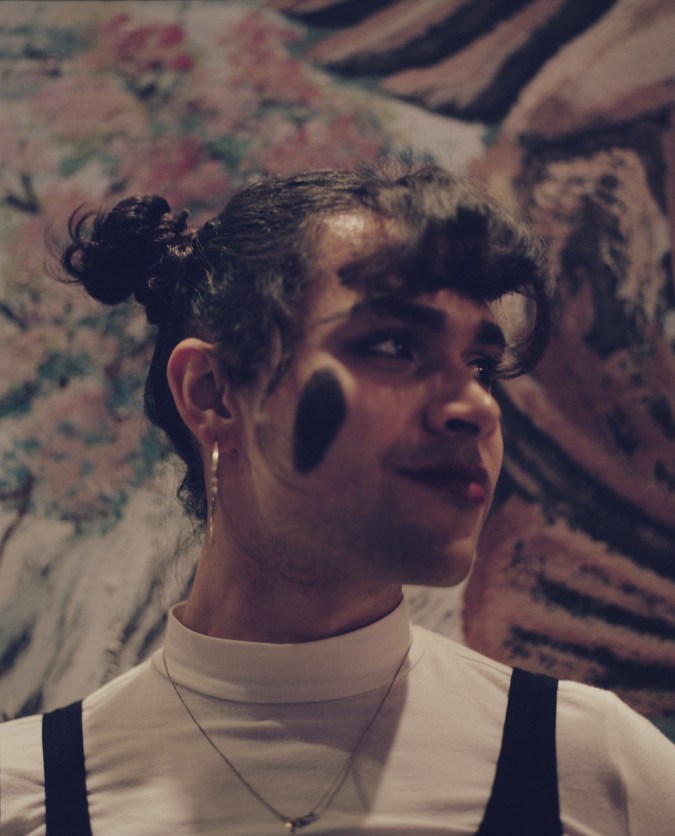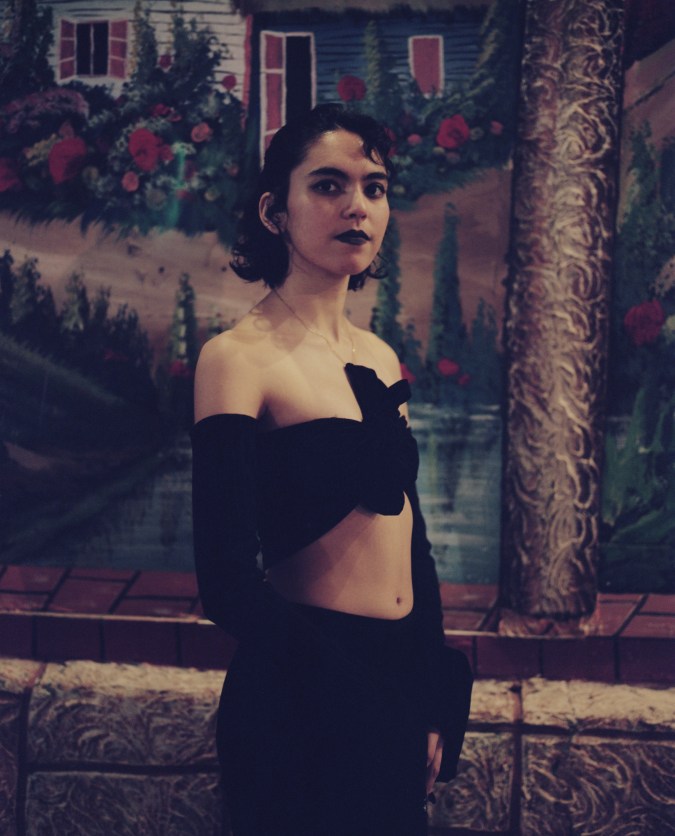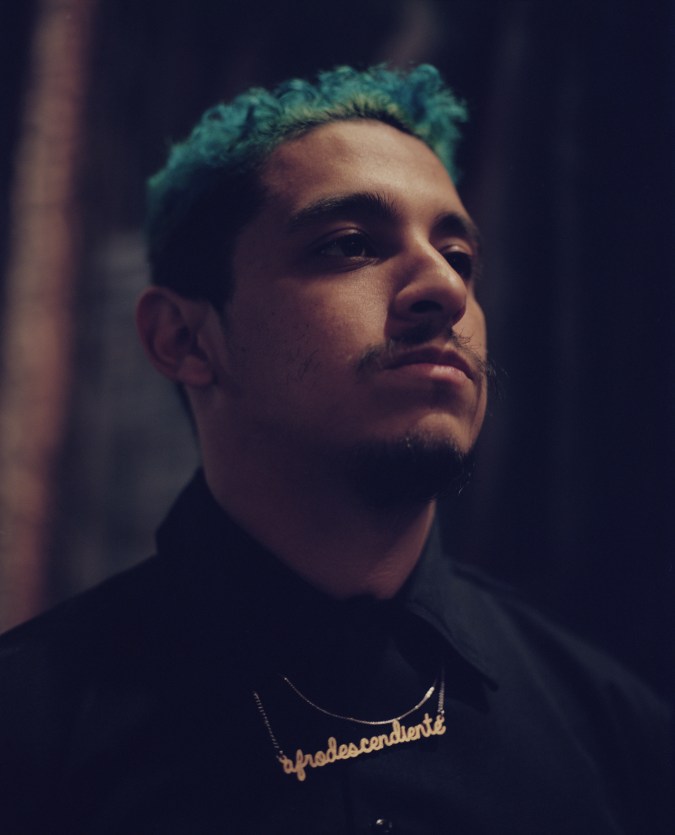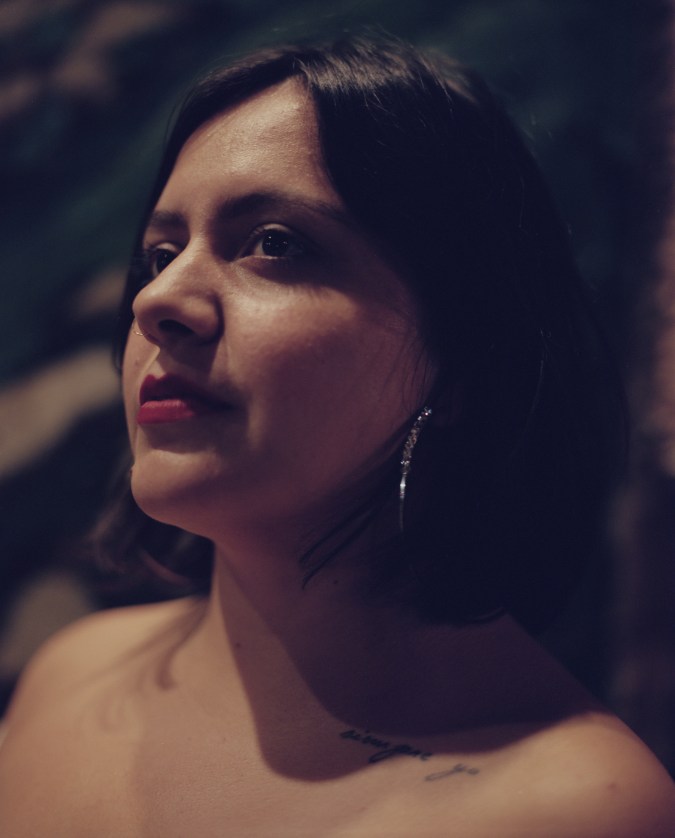It’s an unseasonably warm and sunny day, and the coffee shop where I’m meeting the Sweety’s crew is way too crowded. Ximena Izquierdo Ugaz, Eduardo Restrepo Castaño, Bryan Rodriguez, and Julia Mata are chill about finding more comfortable spot, though. After this they’re going to a photo shoot, and they’re looking fly: white-winged eyeliner, thin hoops, afrodescendiente necklaces, chrome stiletto nails, and blue curls. Eduardo has a rolo on her head, which she takes off mid-interview to reveal the wispiest, most perfectly curled 90s-thin bangs. Together they are Sweety’s, an all-Latinx curatorial collective and platform dedicated to the work and excellence of black and brown people.
“[Sweety’s] was very much triggered by specific circumstances,” Eduardo said. As students of color at the Museum of Fine Arts and Tufts University in Boston – predominantly white institutions in a highly segregated city – they found themselves isolated, lacking support and community. They wanted a space in which they didn’t have to explain themselves, so they created a group called ¡Qué Lástima! alongside other students at SMFA and MassArt. “Being able to be organized as a group also means you can’t be targeted or singled out as a problem-maker in the same way,” Ximena explained. “You can’t be the individual problem if you have people supporting you and next to you.”

At first, the space was a relief. It provided a rare sanctuary where Latinx students could talk openly about art and their experiences without having to explain certain aspects of their identities and lives. “It was really awesome in some ways,” Eduardo explained. “But it grew to have a lot of limitations.” It soon became obvious to the group that there was a lack of accountability from white Latino members and the space they tended to take up. And not everyone who showed up was looking for the same thing. “Part of it was that a lot of the white Latinos in the group were looking for a space where they felt Latino,” Ximena explained. “But for us it was like…we didn’t have to find a place to feel like that. We were being targeted for it.” For ¡Qué Lástima! members who never had any other choice to but to be visible as people of color, dealing with this became burdensome, and in some ways, exactly what they were trying to escape by forming an identity-based group. Among these frustrations, ¡Qué Lástima! disbanded.
Not ones to give up, Julia and Ximena started a platform called Knewbody, a lecture series for artists of color. Unhappy that their predominantly white institutions brought predominantly white artists – to be invited into the classroom, to give talks – they created Knewbody as an intervention. “We were making an alternative curriculum,” Julia explained. Then, though they had tiny studios on campus, they sought out a space that would feel truly theirs. Eduardo found a studio space off campus and decided to invite Julia, Ximena and Bryan to split the rent. It was a home away from the stuffiness of college, a space where they could create and dream more freely. And with that space, they began to see endless opportunity.

After the disappointment of ¡Qué Lástima!, the members who would go on to create Sweety’s came to realize that “Latino” – as a word, as an identity – wasn’t exactly what they meant when creating a group where they might feel at home. That in the end, “Latino” wasn’t really what they meant, or what they wanted. “It wasn’t doing the work we wanted it to do,” explained Bryan, “And we realized that we really meant some other shit,” they laughed.
At the same time that they were struggling with these matters of identity – what felt right, what served their purposes, what nomenclature might do the work – they noticed that they weren’t the only ones feeling this way. They saw the same patterns and frustrations emerging in conversations about Latinidad online, with other people, and throughout history. It was a moment of clarity for the group. “This has been happening,” explained Eduardo.

They decided, this time, to name their configuration as explicitly Black and Brown. “We wanted to be really specific about what we meant when we said ‘people of color,’” explained Bryan. “What our motives were, and how we conceptualize resistance.” Almost immediately after Julia and Ximena got the studio, realizing the possibilities that the space afforded them, they began to plan their first show and party: Tru Love. A new configuration of the old group was coming together, this time with a clearer vision. Sweety’s was born.
“We wanted to be really specific about what we meant when we said ‘people of color.'”
The space proved essential to the work the collective was doing, but it would be short-lived; they were later evicted under somewhat questionable grounds. “We were ‘too loud.’” Ximena said. “Not noise-wise, really. Our presence was loud.” They took it in stride, and had time for one final event: it was a total success. Riding the high of the last event in their cherished space, they launched a GoFundMe to fundraise for a new one.
It was then that Camilo Alvarez – one of the only gallery owners of color in Boston – came across their GoFundMe and reached out to offer a one-year residency at Samson Projects. It was during that time that they began to dream up Sweety’s Radio, a live talk show inspired both by the talk shows quintessential to Latinx households – Laura En América, El Show de Cristina, and Sábado Gigante – and other talk shows, like The Breakfast Club. “We thought, ‘What would it look like for us to have our own talk show?’” Julia explained. “So we started recording live events with small audiences.” They took the opportunity to interview emerging and underground artists, including the likes of Brooklyn emcee Ms. Boogie and Tennessee rapper Bbymutha.

One by one, as they finished school, they began moving to New York City. It wasn’t exactly planned; Eduardo was only supposed to be in the city for a few months, but – as New York does – the city solidified its grip on her. Ximena and Bryan found their way to Brooklyn too, and by the time that Julia graduated – she’s a little younger than the rest – all her friends, and some extended family she was excited to reconnect with, were here in New York. Together again, they started planning for the New York chapter of Sweety’s.
Ever since, they’ve been busy. Between day jobs at museums and galleries across the city, the members of Sweety’s have curated and produced a Ms. Boogie concert, had a residency at a bar called Beverly’s on the Lower East Side, held an education-centric project at Casa Experimental, and had an exhibit at the Cuchifritos Gallery. They plan to launch another season of Sweety’s Radio soon, and there is no shortage of personal artistic endeavors in the works for individual collective members. Their presence in art spaces across the city may remain loud. But their drive and hustle is helping to build a world that just might be ready to listen.
Sweety’s will host a presentation and conversation with Oaxaca-based artist Nelson Morales on April 27. Click here for more info.




